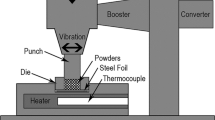Abstract
The present study is dealing with the basic physics for a novel way to generate a free-formed ceramic body, not like common layer by layer, but directly by Selective Volume Sintering (SVS) in a compact block of ceramic powder. To penetrate with laser light into the volume of a ceramic powder compact it is necessary to investigate the light scattering properties of ceramic powders. Compared with polymers and metals, ceramic materials are unique as they offer a wide optical window of transparency. The optical window typically ranges from below 0.3 up to 5 µm wave length. In the present study thin layers of quartz glass (SiO2) particles have been prepared. As a function of layer thickness and the particle size, transmission and reflection spectra in a wave length range between 0.5 and 2.5 µm have been recorded. Depending on the respective particle size and by choosing a proper relation between particle size and wave length of the incident laser radiation, it is found that light can penetrate a powder compact up to a depth of a few millimeters. With an adjustment of the light absorption properties of the compact the initiation of sintering in the volume of the compact is possible.






Similar content being viewed by others
References
ASTM F2792-10: Standard Terminology for Additve Manufacturing Technologies (ASTM, USA, 2012).
G.C. Wei: Transparent ceramic lamp envelope materials. J. Phys. D: Appl. Phys. 38, 3057 (2005).
J.W. Salisbury and A. Wald: The role of volume scattering in reducing spectral contrast of reststrahlen bands in spectra of powder minerals. ICARUS 96, 121 (1992).
J.F. Mustard and J.E. Hays: Effects of hyperfine particles on reflectance spectra from 0.3 to 25 µm. ICARUS 125, 145 (1997).
A.A. Kokhanovsky: On the light scattering in random media with large densely packed particles. J. Geophys. Res. 103, 6089 (1998).
C.F. Bohren: Multiple scattering of light and some of its observables consequences. Am. J. Phys. 55, 524 (1987).
C.F. Bohren and D.R. Huffman: Absorption and Scattering of Light by Small Particles (WILEY-VCH Verlag GmbH & Co. KGaA, Weinheim, Germany, ISBN: 9780471293408, 2007).
S. Gräf, G. Staupendahl, P. Gerinling, and F.A. Müller: Optical constants n and κ of various optical and technical glasses at λ = 10.59 µm. J. Appl. Phys. 113, 013101 (2013).
N.T. Melamed: Optical properties of powders. Part I. Optical absorption coefficients and the absolute value of the diffuse reflectance. J. Appl. Phys. 34, 560 (1963).
J.A. Adam: The mathematical physics of rainbows and glories. Phys. Rep. 356, 229 (2002).
Author information
Authors and Affiliations
Corresponding author
Rights and permissions
About this article
Cite this article
Mühler, T., Helsch, G., Heinrich, J.G. et al. Strategies for the selective volume sintering of ceramics. Journal of Materials Research 29, 2095–2099 (2014). https://doi.org/10.1557/jmr.2014.174
Received:
Accepted:
Published:
Issue Date:
DOI: https://doi.org/10.1557/jmr.2014.174



